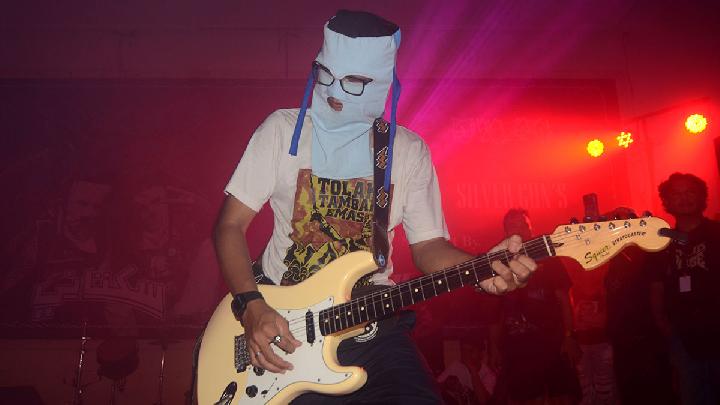TEMPO.CO, Jakarta - A recording purporting to be the voice of Minister of Higher Education, Science, and Technology Satryo Soemantri Brodjonegoro circulated on social media and chat applications on Monday, January 20, 2025. In the recording, which lasts 3 minutes and 20 seconds, the male voice reprimands another man with a soft voice. The two men talked about the water pipe in the house, which was not working.
On the same day that the voice recording was leaked, employees of the Ministry of Higher Education demonstrated at their office in the Senayan area of Central Jakarta. Dressed in black, the employees protested Satryo's leadership. One of the triggers for the demonstration was the dismissal of Neni Herlina, an employee in the Public Relations Officer, Junior Expert, and Budget Officer Department.
According to the investigation by Tempo's fact-check team, the voice recording was first uploaded from the Inilah.com account on the social media platform X. The upload was re-shared up to 9,000 times on X and spread to other social media platforms such as TikTok and Facebook.
Authenticity Test Results
Tempo's fact-check team attempted to verify the authenticity of the recording file allegedly belonging to Minister Satryo. With advances in technology, the voice could have been generated by artificial intelligence (AI). Technology such as an AI voice generator can replicate a voice even though the original voice owner never uttered the sentence. This type of content is known as a deepfake, also known as information that appears real but is actually fake.
The fact-checking team first downloaded the voice recording file circulating on social media. The team saved the full-length file and split the audio into five parts. The audio was split into several parts to focus on the voice allegedly belonging to Satryo, as the full recording also contained another male voice and other noises. In addition, some AI-checking devices limit the length of the digital file that can be analyzed.
Tempo Fact Check team used three deepfake detection devices to verify the authenticity of the audio files circulating on social media. The devices are Hiya Deepfake Voice Detector, AI or Not, and Hive Moderation. The Fact Check team subscribes to AI or Not to optimize its tracking function. In addition, the three devices are references for various fact-checking teams in Indonesia and are recommended by the International Fact-Checking Network - a global fact-checking network based in Florida, United States.
The results of the Hiya Deepfake Voice Detector's examination of the audio file purported to be Minister Satryo's voice showed that the voice's authenticity level was approximately 91-92 percent. According to the device, the voice in the file is authentic and was not created using artificial intelligence technology.
The Hiya Deepfake Voice Detector is a device created by Hiya, a company based in the US. This company focuses on developing the capabilities of its tool to detect fraud and spam. This device is free and can be accessed with a Chrome browser extension.


The second software used by the Fact Check team is the premium AI or Not. This tool was developed by Optic, a US technology company founded by former Google product director Andrey Doronichev. By paying $9 a month, the team can access the full recording and five audio file fragments suspected to be Satryo's voice.
As a result, the AI or Not tool determined that the file suspected of being Satryo's voice was probably not created by artificial intelligence (AI) technology.

Another device manufactured by the US company, Hive, also showed similar results. The Hive moderation device included a statement that there was no interference from artificial intelligence technology in the audio files owned by the fact-checking team.

Expert Analysis
Not stopping at the AI detection tools, the Tempo fact-checking team also sought the opinion of Witness.org, a US-based nonprofit organization focused on technology and human rights. They created the Deepfake Task Force to connect journalists and fact-checkers with experts in media forensics, AI synthesis, and deepfakes. They can provide in-depth analysis of content suspected of being manipulated by artificial intelligence.
The fact-checking team submitted an audio file allegedly to be Satryo's voice circulating on social media and four audio files recorded by mass media. The four audio files were taken from Satryo's statements on Kompas TV, Antara TV, Metro TV, and Satryo's speech during the handover ceremony. The audio was needed to compare the audio files circulating on social media and Satryo's real voice.
In an email on Thursday, January 23, 2025, Witness.org Deepfake Task Force Coordinator Jacobo Castellanos explained their working method to prove the authenticity of the audio file allegedly to be Minister Satryo's voice.
Jacobo said he worked with two teams. The first team analyzed the audio using a combination of human expertise and AI detection tools. "They concluded that the audio was likely authentic," Jacobo wrote in an email.
The first team also looked for different voice modulations and natural responses in the conversation. They found signs that the voice was authentic and unlikely to have been manipulated by an AI device. However, the team also found anomalies that were likely caused by poor recording quality rather than AI manipulation.
Jacobo and his team identified a sign of possible human editing at the 02:05 time code in the audio recording. He suspects that part of the conversation has been removed or spliced in. But Jacobo believes these signs do not indicate manipulation by AI technology. "Based on these findings, the team is confident that the audio is likely authentic," he said.
The second Witness.org team used a different AI detection model. However, they were unable to conclude due to language barriers and poor audio quality.
Digital Forensics Needed
Hudan Setiawan, a lecturer at the Sepuluh Nopember Institute of Technology's Department of Computer Engineering, said that digital forensic tests and examinations must be conducted to prove the authenticity of the audio file suspected to be Minister Satryo's voice. According to Hidan, the police have the authority to obtain evidence such as the device used to record the voice. The authorities must then acquire the files of the evidence to preserve their integrity. "The recordings spread on social media do not meet the criteria for conducting digital forensics," he told Tempo on Tuesday, January 21, 2025.
Statement by Satryo Soemantri Brodjonegoro
The Fact Check team asked the Minister of Higher Education, Science, and Technology, Satryo Soemantri Brodjonegoro, to respond to the findings and results of the audio file examination. He did not respond to WhatsApp messages and calls to his personal number until Friday, January 24, 2025.
On Tuesday, January 21, 2025, Satryo said that the audio that went viral on social media was not his voice. "This is not my voice," said the former chairman of the Indonesian Academy of Sciences. Satryo believes the recording is fake, opening up the possibility of tracking down the creator and distributor of the audio file.
Artika Farmita contributed to this article.
**Do you have information or claims you would like to fact-check? Contact our ChatBot. You can also send criticism, objections, or input for this Cek Fakta article via email [email protected]
Editor's Choice: Indonesian Govt Takes Down Thousands of Deepfake Accounts, Contents ahead of Regional Elections
Click here to get the latest news updates from Tempo on Google News

 4 weeks ago
38
4 weeks ago
38













































